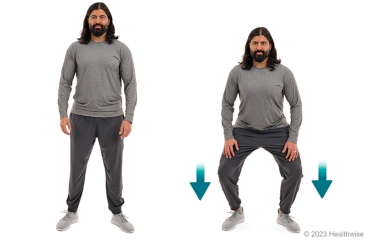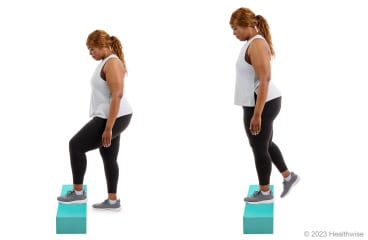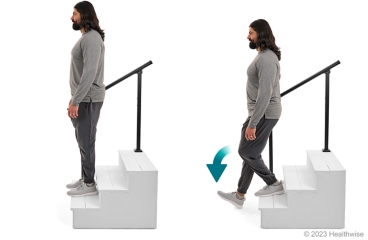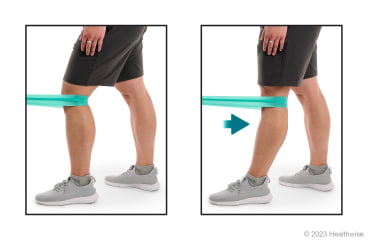Introduction
Here are some examples of exercises for you to try. The exercises may be suggested for a condition or for rehabilitation. Start each exercise slowly. Ease off the exercises if you start to have pain.
You will be told when to start these exercises and which ones will work best for you.
How to do the exercises
Hip flexion (lying down, leg straight)

slide 1 of 6
slide 1 of 6, Hip flexion (lying down, leg straight),
- Lie on your back with your affected leg straight. You can bend your other leg, if that feels more comfortable.
- Tighten the thigh muscles in your affected leg by pressing the back of your knee down. Hold your knee straight.
- Keeping the thigh muscles tight and your leg straight, lift your affected leg up so that your heel is about 12 inches off the floor. Hold for about 6 seconds, then lower slowly.
- Repeat 8 to 12 times.
- It's a good idea to repeat these steps with your other leg.
Short-arc quad

slide 2 of 6
slide 2 of 6, Short-arc quad,
- Lie on your back with your knees bent over a foam roll or a large rolled-up towel.
- Lift the lower part of your affected leg and straighten your knee by tightening your thigh muscle. Keep the back of your knee on the foam roll or rolled-up towel.
- Hold your knee straight for about 6 seconds. Then slowly bend your knee and lower your leg back to the floor.
- Repeat 8 to 12 times.
- It's a good idea to repeat these steps with your other leg.
Half-squat (knees and feet turned out)

slide 3 of 6
slide 3 of 6, Half-squat (knees and feet turned out),
- Stand with your feet about shoulder-width apart. Turn each foot a little toward the outside so your toes aren't facing straight forward.
- Keep your back straight, and tighten your buttocks.
- Slowly bend your knees to lower your body down several inches toward the floor. Keep your heels on the floor. Try to keep your back straight at all times, and do not let your pelvis tilt forward or your knees extend beyond the tip of your toes.
- Repeat 8 to 12 times.
Step-up

slide 4 of 6
slide 4 of 6, Step-up,
- Stand on the floor, facing a bottom step. Or you can use a thick book or a case of soup cans. If you are not steady on your feet, hold on to a chair, counter, or wall while you do this exercise.
- Keeping your back straight, step up with your affected leg. Try not to push with your back leg as you step up. Only use your affected leg to bring you up on to the step. Then lift your other leg on to the step. As you step up, try to keep your knee moving in a straight line with your middle toe.
- Move back to the starting position, with both feet on the floor.
- Repeat 8 to 12 times.
- It's a good idea to repeat these steps with your other leg.
Step-down

slide 5 of 6
slide 5 of 6, Step-down,
- Stand on a bottom step. Or you can use a thick book or a case of soup cans. If you are not steady on your feet, hold on to a handrail, counter, or wall while you do this exercise.
- Slowly step down with your good leg, allowing your heel to lightly touch the floor. As you step down, try to keep your affected knee moving in a straight line toward your middle toe.
- Move back to the starting position, with both feet on the step.
- Repeat 8 to 12 times.
- It's a good idea to repeat these steps with your other leg.
Short-arc (terminal) knee extension (standing)

slide 6 of 6
slide 6 of 6, Short-arc (terminal) knee extension (standing),
- Tie the ends of an exercise band together to form a loop. Attach one end of the loop to a secure object, or shut a door on it to hold it in place.
- Loop the other end of the exercise band around the knee of your affected leg. Keep that leg somewhat bent at the knee.
- Put your good leg about a step behind your affected leg. Then slowly straighten your affected leg by tightening the thigh muscles of that leg.
- Hold for about 6 seconds, then return to the starting position with your knee somewhat bent.
- Rest for up to 10 seconds.
- Repeat 8 to 12 times.
- It's a good idea to repeat these steps with your other leg.
Current as of: July 17, 2023
Author: Healthwise Staff
Clinical Review Board
All Healthwise education is reviewed by a team that includes physicians, nurses, advanced practitioners, registered dieticians, and other healthcare professionals.

